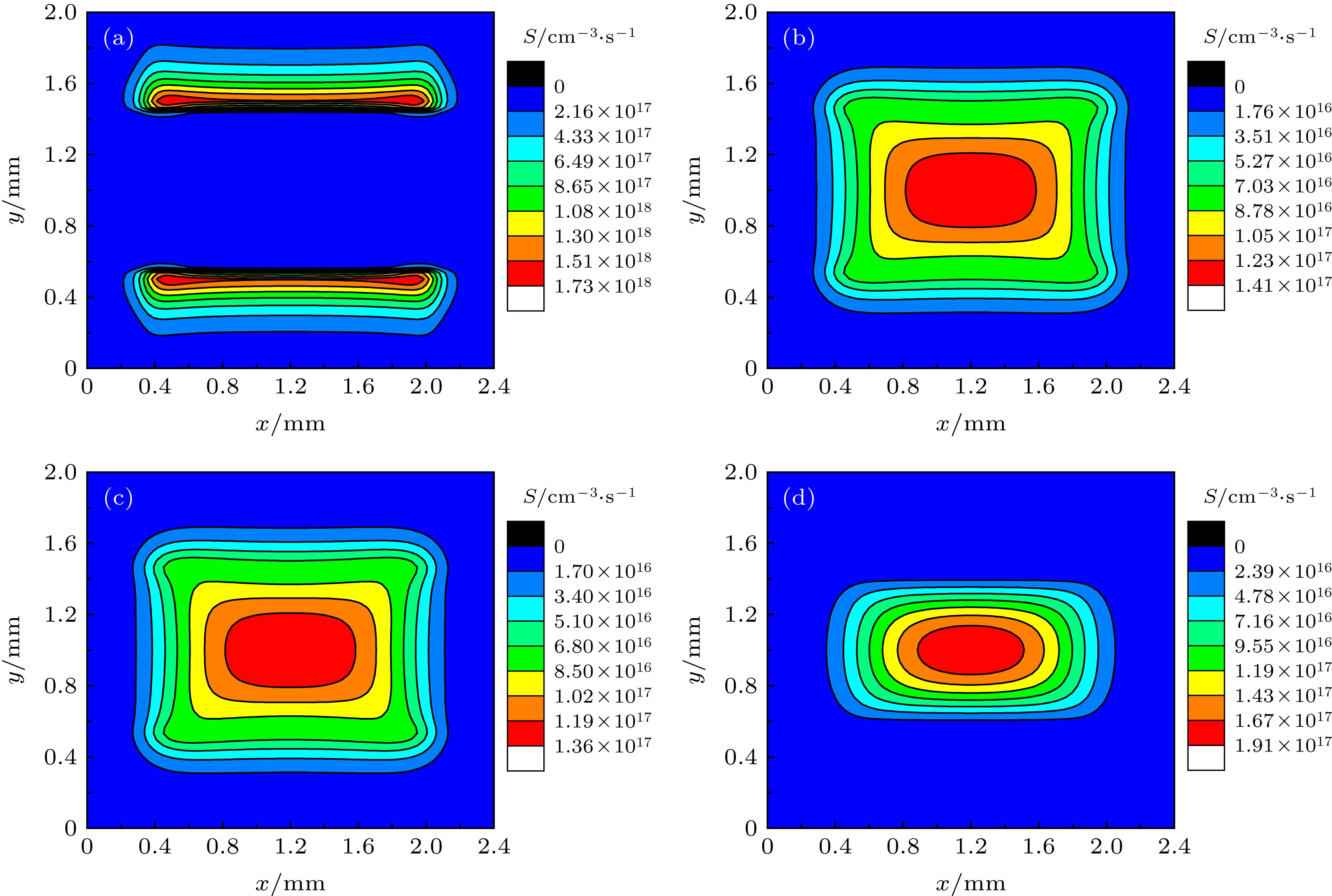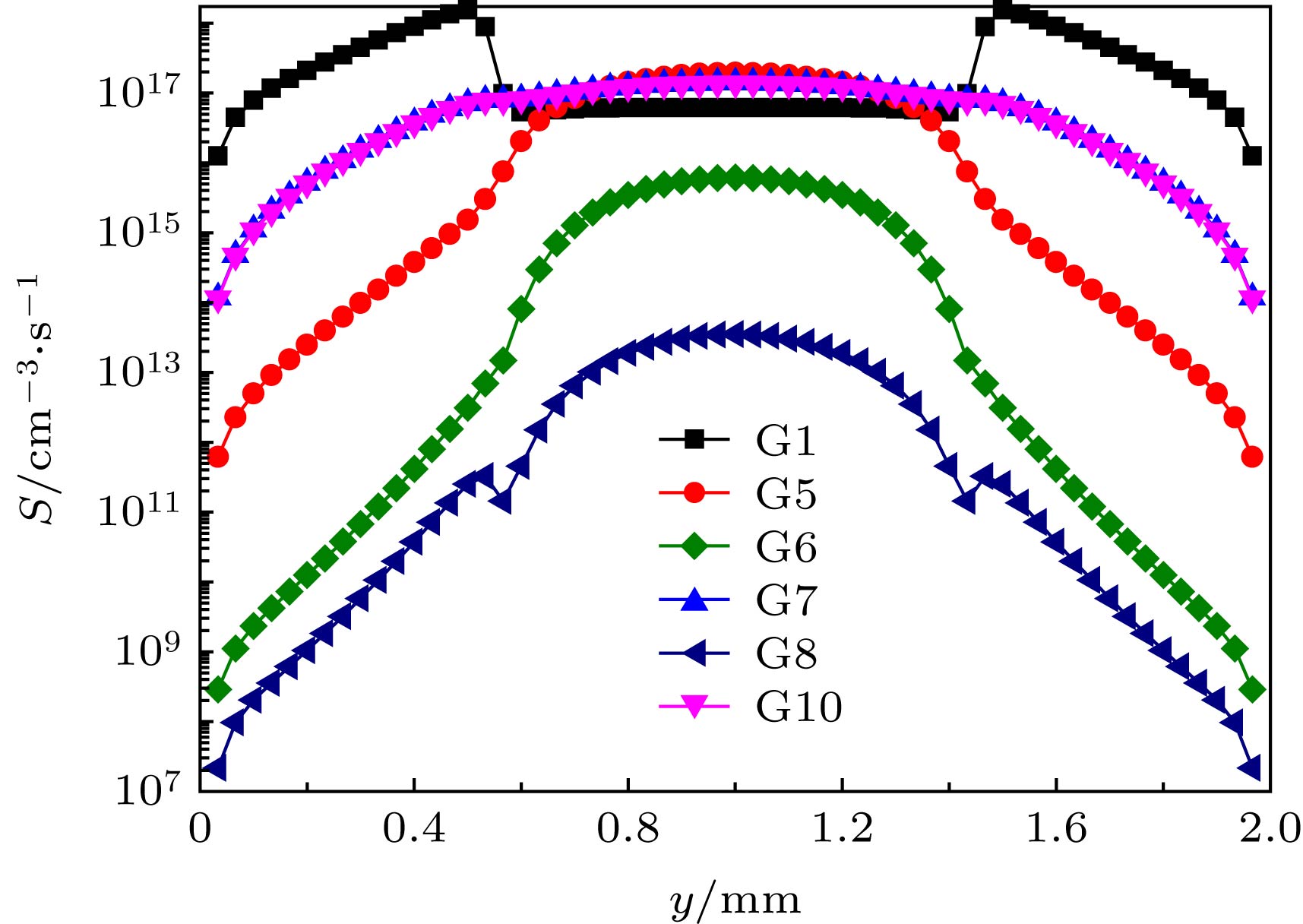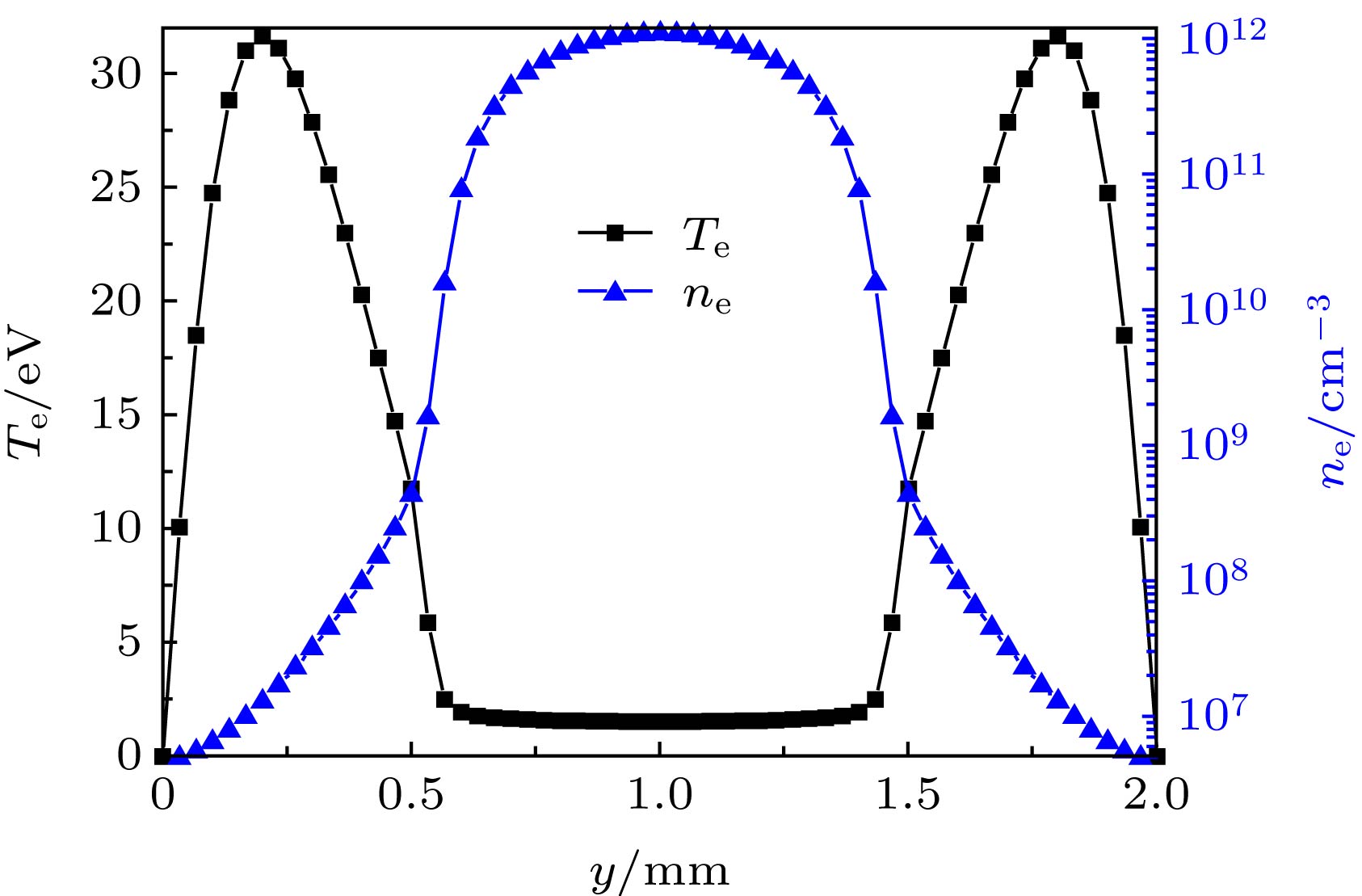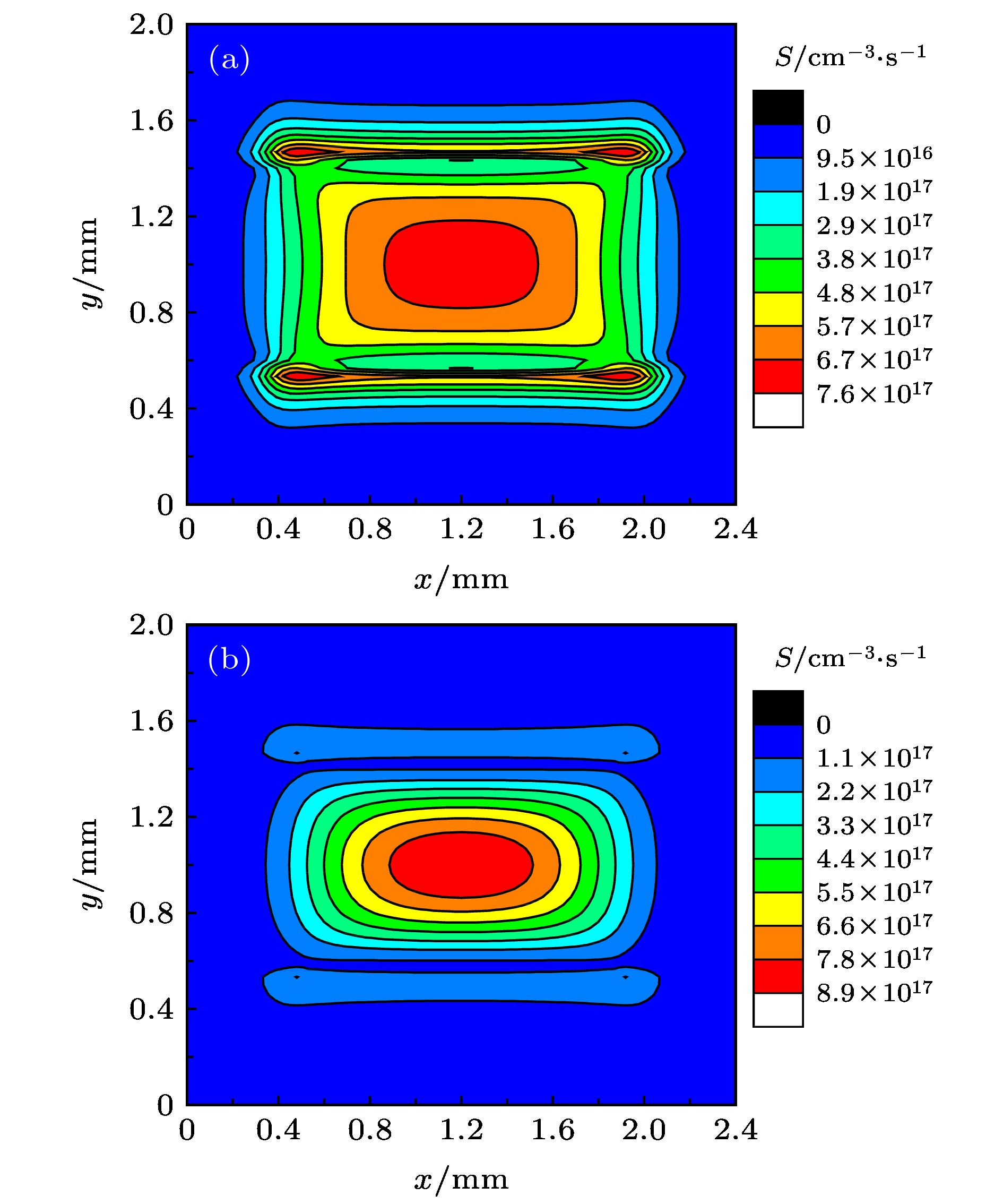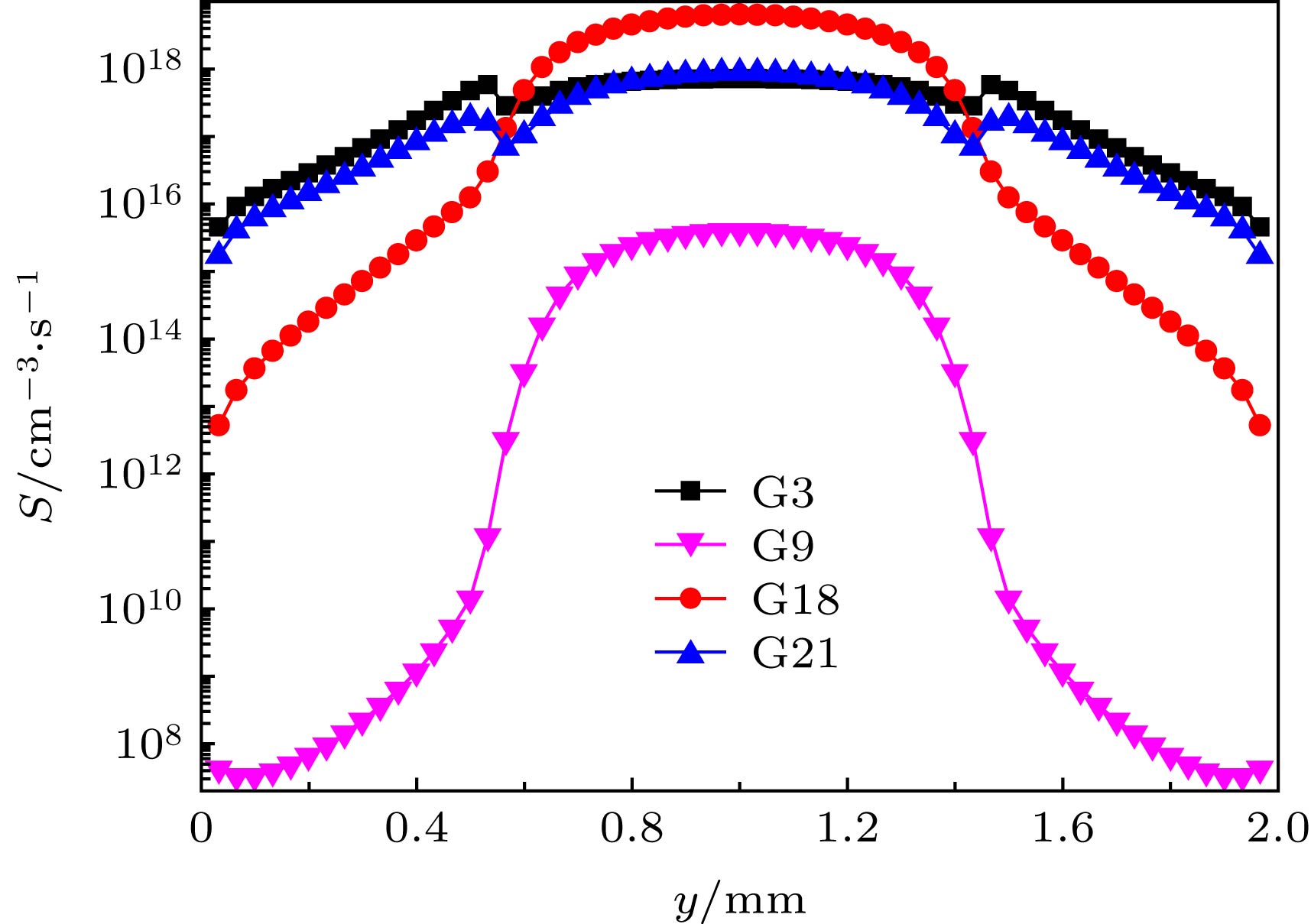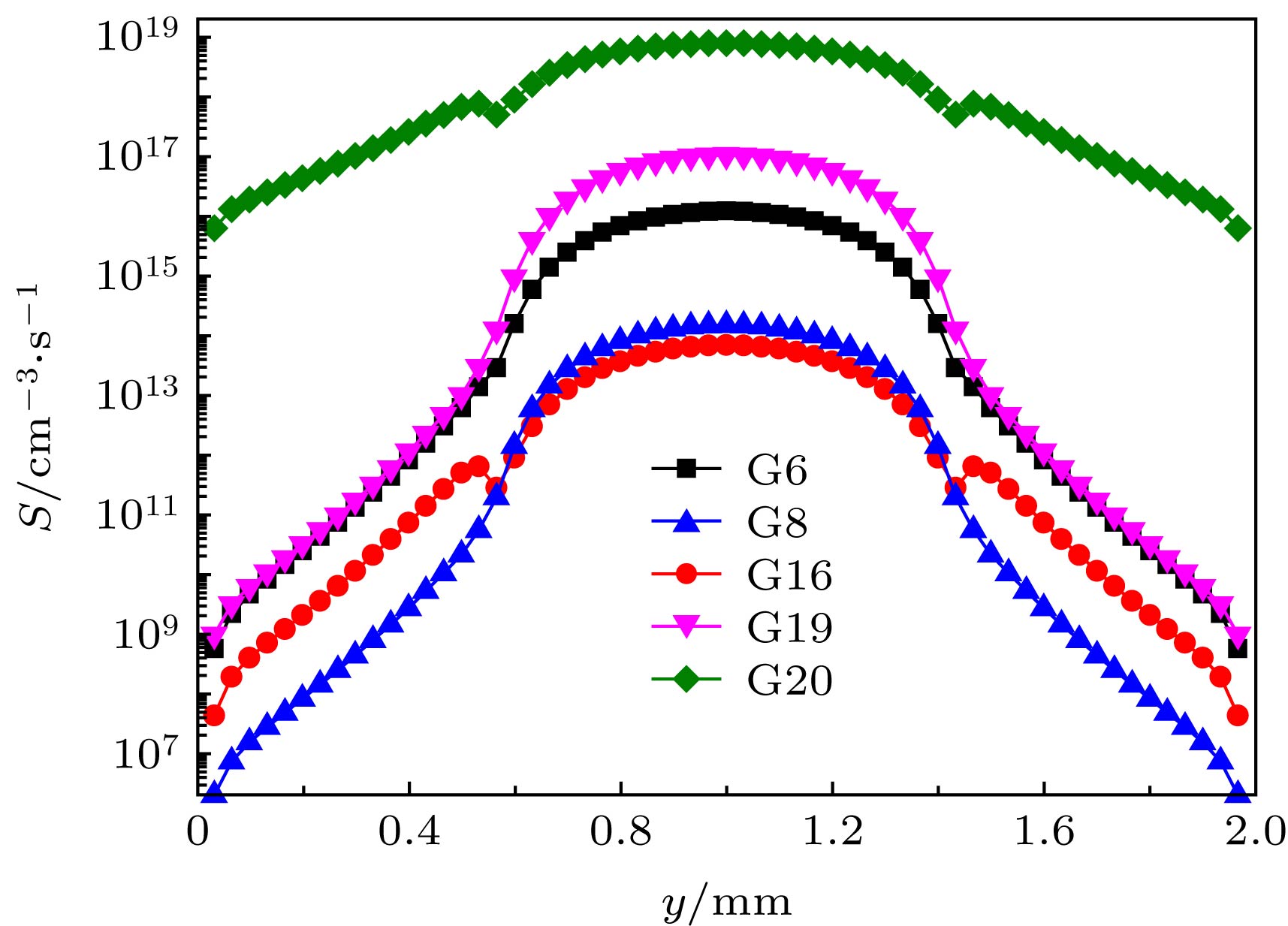-
利用流体模型模拟研究了氩气空心阴极放电的动力学过程. 数值模型考虑了直接基态电离、基态激发、分步电离、潘宁电离、解激发、两体碰撞、三体碰撞、辐射跃迁、弹性碰撞和复合反应等31个反应过程. 计算得到了电子密度, Ar+密度, 激发态氩原子Ar4s、Ar4p、Ar3d能级的密度, 电势和电场强度等的分布特性. 同时模拟得到了不同反应机制对电子、激发态氩原子Ar4s、Ar4p的产生和消耗机理的影响. 结果表明, 在本模拟条件下存在明显的空心阴极效应, 激发态氩原子Ar4s的密度大大高于电子密度. 激发态氩原子Ar4s参与的潘宁电离2Ar4s → Ar+ + Ar + e和分步电离对新电子的产生和电子能量的平衡具有重要贡献, 特别是以往模拟中通常被忽略的产生Ar2+的潘宁电离反应2Ar4s → Ar2+ + e同样对电子的产生具有重要影响. 激发态氩原子密度的空间分布是放电过程中各种粒子生成和消耗相互平衡的结果. 本模型所包含的反应中, 激发态氩原子Ar4p退激发到Ar4s能级的辐射反应Ar4p → Ar4s + hν是Ar4s能级产生的主要来源, 同时也是激发态氩原子Ar4p消耗的主要途径. 电子碰撞Ar4s激发到Ar4p能级的反应 Ar4s + e → Ar4p + e是激发态氩原子Ar4s消耗的主要途径, 也是产生激发态氩原子Ar4p的主要途径. 模拟结果同时表明, 利用激发态氩原子Ar4p能级的分布特性能够更好地反映空心阴极放电中的光学特性.In this paper, the dynamics of hollow cathode discharge in argon is simulated by fluid model. In the numerical model considered are 31 reaction processes, including direct ground state ionization, ground state excitation, stepwise ionization, Penning ionization, de-excitation, two-body collision, three-body collision, radiation transition, elastic collision, and electron-ion recombination reaction. The electron density, Ar+ density, Ar4s, Ar4p, Ar3d particle density, electric potential and electric field intensity are calculated. At the same time, the contributions of different reaction mechanisms for the generation and consumption of electron, Ar4s and Ar4p are simulated. The results indicate that hollow cathode effect exists in the discharge, and the Ar4s density is much higher than electron density. The penning ionization 2Ar4s → Ar+ + Ar+ + e and stepwise ionization involving Ar4s make important contributions to the generation of new electrons and the balance of electron energy. In particular, the penning ionization reaction 2Ar4s → Ar2+ + e, which is generally ignored in previous simulation, also has an significant influence on electron generation. The spatial distribution of excited state argon atomic density is the result of the balance between the formation and consumption of various particles during discharge. Radiation reaction Ar4p → Ar4s + hν is the main source of Ar4s generation and the main way to consume Ar4p. Ar4s + e →Ar4p + e is the main way of Ar4s consumption and Ar4p production. The simulation results also show that the Ar4p density distribution can better reflect the optical characteristics in the hollow cathode discharge.
-
Keywords:
- hollow cathode discharge /
- fluid model /
- excited state atom /
- reaction mechanism
[1] 欧阳吉庭, 张宇, 秦宇 2016 高电压技术 42 673
 Google Scholar
Google Scholar
Ouyang J T, Zhang Y, Qin Y 2016 High Volt. Eng. 42 673
 Google Scholar
Google Scholar
[2] Hou X Y, Fu Y Y, Wang H, Zou X B, Luo H Y, Wang X X 2017 Phys. Plasma 24 083506
 Google Scholar
Google Scholar
[3] Fu Y Y, Verboncoeur J P, Christlieb A J 2017 Phys. Plasmas 24 103514
 Google Scholar
Google Scholar
[4] Baguer N, Bogaerts A, Donko Z, Gijbels R, Sadeghi N 2005 J. Appl. Phys. 97 123305
 Google Scholar
Google Scholar
[5] Ferreira N P, Strauss J A, Human H G C 1982 Spectrochimica Acta Part B 37 273
 Google Scholar
Google Scholar
[6] Slevin P J, Harrison W W 1975 Appl. Spectrosc. Rev. 10 201
 Google Scholar
Google Scholar
[7] Roberto M, Smith H B, Verboncoeur J P 2003 IEEE Trans. Plasma- Sci. 31 1292
 Google Scholar
Google Scholar
[8] Wiese W L, Braulk J W, Danzmann K, Kock M 1989 Phys. Rev. A 39 2461
 Google Scholar
Google Scholar
[9] Miclea M, Kunze K, Heitmann U, Florek S, Franzke J, Niemax K 2005 J. Phys. D: Appl. Phys. 38 1709
 Google Scholar
Google Scholar
[10] Penache C, Miclea M, Bräuning-Demian A, Hohn O, Schössler S, T Jahnke T, Niemax K, Schmidt-Böcking H 2002 Plasma Sources Sci. Technol. 11 476
 Google Scholar
Google Scholar
[11] 张增辉, 张冠军, 邵先军, 常正实, 彭兆裕, 许昊 2012 24 245205
 Google Scholar
Google Scholar
Zhang Z H, Zhang G J, Shao X J, Chang Z S, Peng Z Y, Xu H 2012 Acta Phys. Sin. 24 245205
 Google Scholar
Google Scholar
[12] Lazzaroni C, Chabert P 2016 Plasma Sources Sci. Technol. 25 065015
 Google Scholar
Google Scholar
[13] Eggarter E 1975 J. Chem. Phys. 62 833
 Google Scholar
Google Scholar
[14] Eduardo C M, Moisan M 2010 Spectrochimica Acta B 65 199
 Google Scholar
Google Scholar
[15] Lymberopoulos D P, Economou D J 1993 J. Appl. Phys. 73 3668
 Google Scholar
Google Scholar
[16] Shon J W, Kushner M J 1994 J. Appl. Phys. 75 1883
 Google Scholar
Google Scholar
[17] Gudmundsson J T, Thorsteinsson E G 2007 Plasma Sources Sci. Technol. 16 399
 Google Scholar
Google Scholar
[18] Li Z, Zhao Z, Li X H 2012 Phys. Plasma 19 033510
 Google Scholar
Google Scholar
[19] Epstein I L, Gavrilovic M, Jovicevic S, Konjevic N, Lebedev Y A, Tatarinov A V 2014 Eur. Phys. J. D 68 334
 Google Scholar
Google Scholar
[20] Shkurenkov I A, Mankelevich Y A, Rakhimova T V 2009 Phys. Rev. E 79 046406
 Google Scholar
Google Scholar
[21] Moravej M, Yang X, Barankin M, Penelon J, Babayan S E, Hicks R F 2006 Plasma Source Sci. Tech. 15 204
 Google Scholar
Google Scholar
[22] Annemie B, Renaat G, Wim G 1999 Jpn. J. Appl. Phys. 38 4404
 Google Scholar
Google Scholar
[23] 夏广庆, 薛伟华, 陈茂林, 朱雨, 朱国强 2011 60 015201
 Google Scholar
Google Scholar
Xia G Q, Xue W H, Chen M L, Zhu Y, Zhu G Q 2011 Acta Phys. Sin. 60 015201
 Google Scholar
Google Scholar
[24] 何寿杰, 张钊, 赵雪娜, 李庆 2017 66 055101
 Google Scholar
Google Scholar
He S J, Zhang Z, Zhao Xue N, Li Q 2017 Acta Phys. Sin. 66 055101
 Google Scholar
Google Scholar
[25] 付洋洋, 罗海云, 邹晓兵, 王强, 王新新 2014 63 095206
 Google Scholar
Google Scholar
Fu Y Y, Luo H Y, Zou X B, Wang Q, Wang X X 2014 Acta Phys. Sin. 63 095206
 Google Scholar
Google Scholar
[26] Fu Y Y, Verboncoeur J P, Christlieb A J, Wang X X 2017 Phys. Plasmas 24 083516
 Google Scholar
Google Scholar
[27] Hagelaar G J, Hoog F J, Kroesen G M 2000 Phys. Rev. E 62 1452
[28] 徐学基, 诸定昌 1996 气体放电物理 (上海: 复旦大学出版社)
Xue X J, Zhu D C 1996 Physics of Gas Discharge (Shanghai: Fudan University Press) (in Chinese)
[29] Fu Y Y, Krek J, Parsry G M, Verboncoeur J P 2018 Phys. Plasma 25 033505
 Google Scholar
Google Scholar
[30] Bogaerts A, Guenard R D, Smith B W 1997 Spectrochimica Acta Part B 52 219
 Google Scholar
Google Scholar
[31] Uzelac N I, Leis F 1992 Spectrochim. Acta B 47 877
 Google Scholar
Google Scholar
[32] Strauss J A, Ferreira N P, Human H G C 1982 Spectrochim Acta B 37 273
[33] Bogaerts A, Gijbels R 1995 Phys. Rev. A 52 3743
 Google Scholar
Google Scholar
[34] Bánó G, Donkó Z 2012 Plasma Sources Sci. Technol. 21 035011
 Google Scholar
Google Scholar
[35] Bogaerts A, Gijbels R 2002 J. Appl. Phys. 92 6408
 Google Scholar
Google Scholar
[36] Kutasi K, Donkó Z 2000 J. Phys. D: Appl. Phys. 33 1081
 Google Scholar
Google Scholar
[37] Bogaerts A, Gijbels R, Vlcek J 1998 Spectrochimica Acta Part B 53 1517
 Google Scholar
Google Scholar
-
表 1 放电反应类型
Table 1. Discharge reactions in the model.
反应
标号反应方程 反应
标号反应方程 G1 Ar + e → Ar+ + 2e[12] G17 Ar4s + e → Ar3d + e[16] G2 Ar + e → Ar4s + e[13] G18 Ar4s + e → Ar4p + e[12] G3 Ar + e → Ar4p + e[13] G19 Ar4p + e → Ar4s + e[12] G4 Ar + e → Ar3d + e[13] G20 Ar4p → Ar4s + hν[17] G5 Ar4s + e → Ar+ + 2e[14] G21 Ar3d → Ar4p[16] G6 Ar4p + e → Ar+ + 2e[14] G22 Ar+ + 2e → Ar + e[14] G7 2Ar4s → Ar+ + Ar + e[15] G23 Ar+ + e → Ar4s[12] G8 2Ar4p → Ar+ + Ar + e[16] G24 Ar+ + 2e → Ar4s + e[12] G9 2Ar4s → Ar2+ + e[17] G25 Ar2+ + e → 2Ar[19] G10 Ar4s + Ar → 2Ar[18] G26 Ar2+ + e → Ar+ + Ar + e[20] G11 Ar4s + 2Ar → 3Ar[18] G27 Ar2+ + e → Ar4s + Ar[16] G12 2Ar + Ar+ → Ar2+ + Arr[16] G28 Ar2+ + e → 2Ar4s[21] G13 Ar4s + 2Ar → Ar2 + Ar[15] G29 Ar2+ + e → Ar4p + Ar[16] G14 Ar4s + e → Ar + e[12] G30 Ar2+ + e → Ar3d + Ar[16] G15 Ar4s → Ar + hν[12] G31 Ar + e → Ar + e[22] G16 Ar4p +e → Ar + e[12] 表 2 不同电离反应速率的平均值
Table 2. Average values of the different ionization rates in the discharge region.
反应标号 反应方程 速率平均值/cm–3·s–1 G1 Ar + e → Ar+ + 2e 2.5 × 1017 G5 Ar4s + e → Ar+ + 2e 2.6 × 1016 G6 Ar4p + e → Ar+ + 2e 1.1 × 1015 G7 2Ar4s → Ar+ + Ar + e 3.9 × 1016 G8 2Ar4p → Ar+ + Ar + e 2.9 × 1012 G10 2Ar4s → Ar2+ + e 3.8 × 1016 表 3 Ar4s生成速率平均值
Table 3. Average values of the different production rates of Ar4s in the discharge region.
反应标号 反应方程 源项平均值/cm–3·s–1 G2 Ar + e → Ar4s + e 1.6 × 1017 G19 Ar4p + e → Ar4s + e 9.1 × 1015 G20 Ar4p → Ar4s + hν 11.8 × 1017 G24 Ar+ + 2e → Ar4s + e 55.3 G23 Ar + e → Ar4s 4.4 × 1012 G27 Ar2+ + e → Ar4s + Ar 4.3 × 1015 G28 Ar2+ + e → 2Ar4s 3.9 × 1014 表 4 消耗Ar4s的不同反应速率的平均值
Table 4. Average values of the different consuming rates of Ar4s in the discharge region.
反应标号 反应方程 源项平均值/cm–3·s–1 G5 Ar4s + e → Ar+ + 2e 2.6 × 1016 G7 2Ar4s → Ar+ +Ar + e 7.9 × 1016 G9 Ar4s + Ar → 2Ar 3.0 × 1015 G10 2Ar4s → Ar2+ + e 7.6 × 1016 G11 Ar4s + 2Ar → 3Ar 4.5 × 1015 G13 Ar4s + 2Ar → Ar2 + Ar 3.5 × 1016 G14 Ar4s + e → Ar + e 1.2 × 1015 G15 Ar4s → Ar + hν 1.9 × 1017 G17 Ar4s + e → Ar3d + e 1.2 × 1017 G18 Ar4s + e → Ar4p + e 8.2 × 1017 表 5 Ar4p生成速率平均值
Table 5. Average values of the different production rates of Ar4p in the discharge region.
反应标号 反应方程 源项平均值/cm–3·s–1 G3 Ar + e → Ar4p + e 2.2 × 1017 G18 Ar4s + e → Ar4p + e 8.2 × 1017 G21 Ar3d → Ar4p 1.4 × 1017 G29 Ar2+ + e → Ar4p + Ar 4.3 × 1014 表 6 消耗Ar4p的不同反应速率的平均值
Table 6. Average values of the different consuming rates of Ar4p in the discharge region
反应标号 反应方程 源项平均值/cm–3·s–1 G6 Ar4p + e→Ar+ + 2e 1.1 × 1015 G8 2Ar4p→Ar+ + Ar + e 5.8 × 1012 G16 Ar4p +e→Ar + e 1.3 × 1013 G19 Ar4p + e→Ar4s + e 9.1 × 1015 G20 Ar4p→Ar4s + hν 11.8 × 1017 -
[1] 欧阳吉庭, 张宇, 秦宇 2016 高电压技术 42 673
 Google Scholar
Google Scholar
Ouyang J T, Zhang Y, Qin Y 2016 High Volt. Eng. 42 673
 Google Scholar
Google Scholar
[2] Hou X Y, Fu Y Y, Wang H, Zou X B, Luo H Y, Wang X X 2017 Phys. Plasma 24 083506
 Google Scholar
Google Scholar
[3] Fu Y Y, Verboncoeur J P, Christlieb A J 2017 Phys. Plasmas 24 103514
 Google Scholar
Google Scholar
[4] Baguer N, Bogaerts A, Donko Z, Gijbels R, Sadeghi N 2005 J. Appl. Phys. 97 123305
 Google Scholar
Google Scholar
[5] Ferreira N P, Strauss J A, Human H G C 1982 Spectrochimica Acta Part B 37 273
 Google Scholar
Google Scholar
[6] Slevin P J, Harrison W W 1975 Appl. Spectrosc. Rev. 10 201
 Google Scholar
Google Scholar
[7] Roberto M, Smith H B, Verboncoeur J P 2003 IEEE Trans. Plasma- Sci. 31 1292
 Google Scholar
Google Scholar
[8] Wiese W L, Braulk J W, Danzmann K, Kock M 1989 Phys. Rev. A 39 2461
 Google Scholar
Google Scholar
[9] Miclea M, Kunze K, Heitmann U, Florek S, Franzke J, Niemax K 2005 J. Phys. D: Appl. Phys. 38 1709
 Google Scholar
Google Scholar
[10] Penache C, Miclea M, Bräuning-Demian A, Hohn O, Schössler S, T Jahnke T, Niemax K, Schmidt-Böcking H 2002 Plasma Sources Sci. Technol. 11 476
 Google Scholar
Google Scholar
[11] 张增辉, 张冠军, 邵先军, 常正实, 彭兆裕, 许昊 2012 24 245205
 Google Scholar
Google Scholar
Zhang Z H, Zhang G J, Shao X J, Chang Z S, Peng Z Y, Xu H 2012 Acta Phys. Sin. 24 245205
 Google Scholar
Google Scholar
[12] Lazzaroni C, Chabert P 2016 Plasma Sources Sci. Technol. 25 065015
 Google Scholar
Google Scholar
[13] Eggarter E 1975 J. Chem. Phys. 62 833
 Google Scholar
Google Scholar
[14] Eduardo C M, Moisan M 2010 Spectrochimica Acta B 65 199
 Google Scholar
Google Scholar
[15] Lymberopoulos D P, Economou D J 1993 J. Appl. Phys. 73 3668
 Google Scholar
Google Scholar
[16] Shon J W, Kushner M J 1994 J. Appl. Phys. 75 1883
 Google Scholar
Google Scholar
[17] Gudmundsson J T, Thorsteinsson E G 2007 Plasma Sources Sci. Technol. 16 399
 Google Scholar
Google Scholar
[18] Li Z, Zhao Z, Li X H 2012 Phys. Plasma 19 033510
 Google Scholar
Google Scholar
[19] Epstein I L, Gavrilovic M, Jovicevic S, Konjevic N, Lebedev Y A, Tatarinov A V 2014 Eur. Phys. J. D 68 334
 Google Scholar
Google Scholar
[20] Shkurenkov I A, Mankelevich Y A, Rakhimova T V 2009 Phys. Rev. E 79 046406
 Google Scholar
Google Scholar
[21] Moravej M, Yang X, Barankin M, Penelon J, Babayan S E, Hicks R F 2006 Plasma Source Sci. Tech. 15 204
 Google Scholar
Google Scholar
[22] Annemie B, Renaat G, Wim G 1999 Jpn. J. Appl. Phys. 38 4404
 Google Scholar
Google Scholar
[23] 夏广庆, 薛伟华, 陈茂林, 朱雨, 朱国强 2011 60 015201
 Google Scholar
Google Scholar
Xia G Q, Xue W H, Chen M L, Zhu Y, Zhu G Q 2011 Acta Phys. Sin. 60 015201
 Google Scholar
Google Scholar
[24] 何寿杰, 张钊, 赵雪娜, 李庆 2017 66 055101
 Google Scholar
Google Scholar
He S J, Zhang Z, Zhao Xue N, Li Q 2017 Acta Phys. Sin. 66 055101
 Google Scholar
Google Scholar
[25] 付洋洋, 罗海云, 邹晓兵, 王强, 王新新 2014 63 095206
 Google Scholar
Google Scholar
Fu Y Y, Luo H Y, Zou X B, Wang Q, Wang X X 2014 Acta Phys. Sin. 63 095206
 Google Scholar
Google Scholar
[26] Fu Y Y, Verboncoeur J P, Christlieb A J, Wang X X 2017 Phys. Plasmas 24 083516
 Google Scholar
Google Scholar
[27] Hagelaar G J, Hoog F J, Kroesen G M 2000 Phys. Rev. E 62 1452
[28] 徐学基, 诸定昌 1996 气体放电物理 (上海: 复旦大学出版社)
Xue X J, Zhu D C 1996 Physics of Gas Discharge (Shanghai: Fudan University Press) (in Chinese)
[29] Fu Y Y, Krek J, Parsry G M, Verboncoeur J P 2018 Phys. Plasma 25 033505
 Google Scholar
Google Scholar
[30] Bogaerts A, Guenard R D, Smith B W 1997 Spectrochimica Acta Part B 52 219
 Google Scholar
Google Scholar
[31] Uzelac N I, Leis F 1992 Spectrochim. Acta B 47 877
 Google Scholar
Google Scholar
[32] Strauss J A, Ferreira N P, Human H G C 1982 Spectrochim Acta B 37 273
[33] Bogaerts A, Gijbels R 1995 Phys. Rev. A 52 3743
 Google Scholar
Google Scholar
[34] Bánó G, Donkó Z 2012 Plasma Sources Sci. Technol. 21 035011
 Google Scholar
Google Scholar
[35] Bogaerts A, Gijbels R 2002 J. Appl. Phys. 92 6408
 Google Scholar
Google Scholar
[36] Kutasi K, Donkó Z 2000 J. Phys. D: Appl. Phys. 33 1081
 Google Scholar
Google Scholar
[37] Bogaerts A, Gijbels R, Vlcek J 1998 Spectrochimica Acta Part B 53 1517
 Google Scholar
Google Scholar
计量
- 文章访问数: 10547
- PDF下载量: 134
- 被引次数: 0













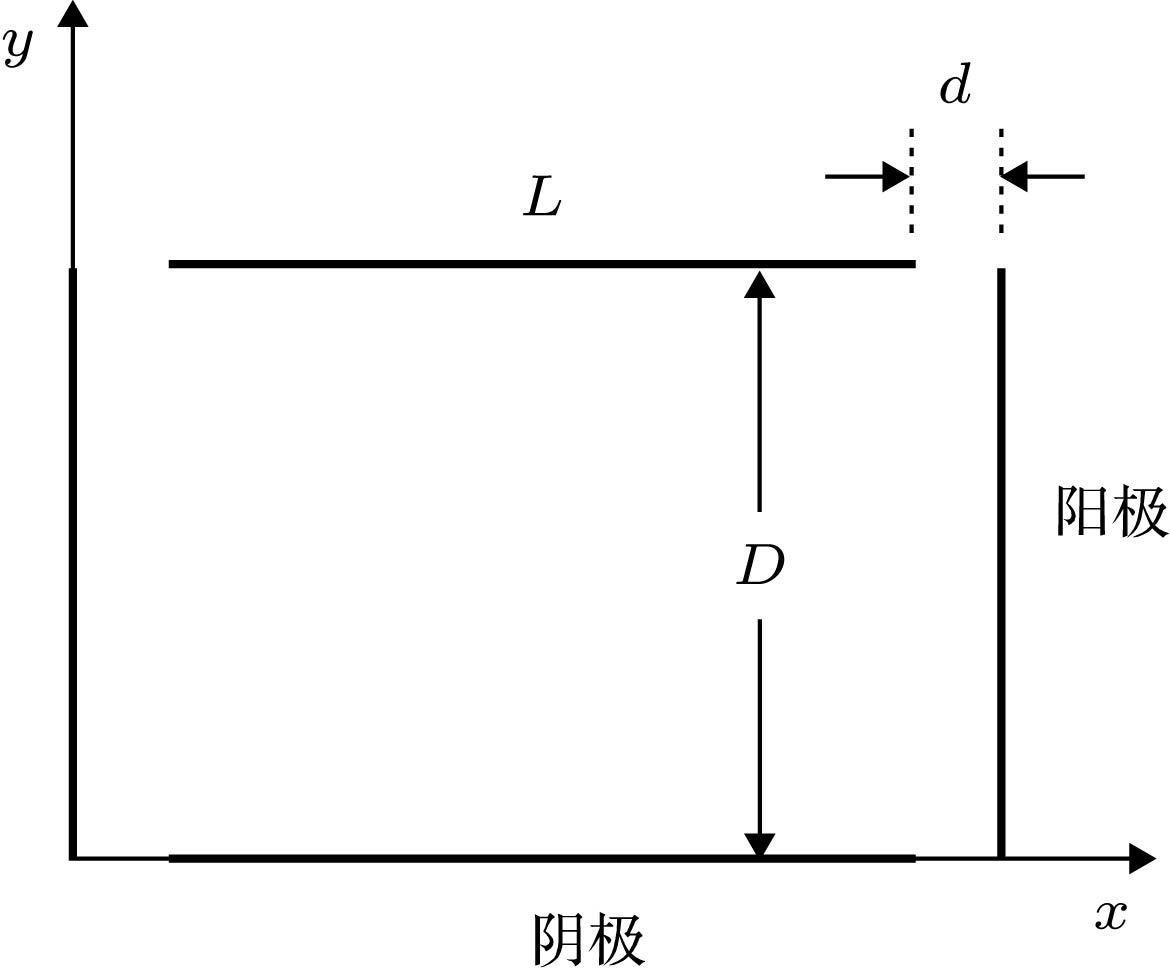
 下载:
下载:



